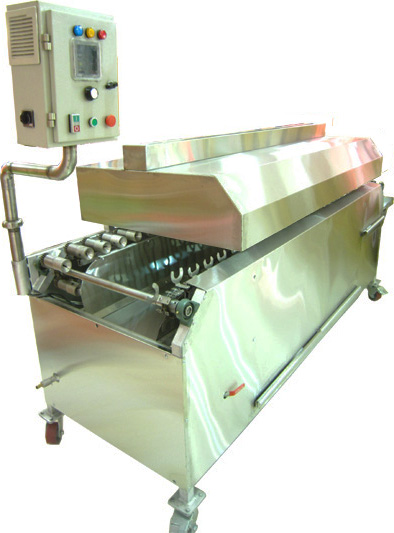scythian500
SENIOR MEMBER

- Joined
- Nov 16, 2014
- Messages
- 2,211
- Reaction score
- 1
- Country
- Location
The funny thing is that technology even entered these totally ancient recipes in Iran today. There are lots of automatic machinery in restaurants around Iran making customers delicious kebabs in all forms!!Kabab Chenjeh: Chenjeh is pure meat and very similar to western steaks. However, unlike most of Iranian Kebabs, onion is not used in prepration. Chenjeh is usually made from the meat of newly slaughtered sheep, when it’s still soft and fresh.
Mahi Kabab: Mahi Kabab or barbecued fish is popular in both northern and southern Iran, particularly in Caspian sea and Persian Gulf regions. However white fish (Caspian Kutum) from the Caspian Sea is among the preferred type for the dish.
Mahi Kabab
Recipe for Kabab Koobideh: (4 servings)
Ingredients:
1 kilograms ground meat (lamb or beef or a mix of both and grind finely 2,3 times)
1 large onion (grated)
2 large egg yolk (beaten)
4 medium tomatoes
1 teaspoon baking soda
1 teaspoon salt
3 spoonful boiled saffron
1/2 teaspoon black pepper
1 tablespoon sumac
PREPARATIONS:
1- Soak 1/2 Tsp saffron in a class of hot water, cover the glass with a lid and leave it to give out its color. You will need 3 spoonful of the result for Kabab Koobideh and can keep the leftover in the fridge for long time.
2- Grate the onions and drain the excessive juice.
DIRECTION:
1. Mix meat, onion, eggs, baking soda, 3 spoonful of boiled saffron, salt and paper well with your hands in a large bowl until the mixture becomes well blended. The result should be sticky like dough. Leave it aside for 2 hours.
2. Take a handful of meat and place it on the long, thick metal skewers, press the meat around oval and shape evenly flat. +
3. If the meat is sticky, leave a bowl of water next to you to drip in your hand while placing the meat to prevent the stickiness.
4. Thread whole tomatoes on another skewer.
5. Barbeque each side for about five minutes, turning frequently. If skewers are not available or barbequing is not possible, kabab-e koobideh can be shaped into long, thin portions on aluminum foil and grilled at high temperature in the oven. The oven should be pre-heated and kabab-e koobideh should be placed as high as possible near the source of the heat.
Kabab Koobideh on Fire
Serve with hot Polow (Chelow) or on Iranian bread. If serving with rice, may be topped by butter and some sumac. If kabab-e koobideh was made in an oven, the juice from the kabab can be poured on rice or bread.
Recipe for Rice (Polow) : (4 Servings)
4 cups long-grain rice or basmati
6 tablespoons cooking oil
1 tablespoon salt
3 spoonful butter
1 or 2 spoonful saffron ( You may use the leftovers from the Kabab Koobideh recipe)
DIRECTION:
The preparation of Iranian polow (chelow) is a delicious non-sticky rice, normally served with kababs or any of the main Persian dishes.
Wash rice twice and soak in salted warm water for 2-3 hours, then drain the water. Pour water in a large pan until it is half-full and bring it to a boil.
Add rice and a spoonful of salt and continue boiling until rice slightly softens. (The rice should become soft but slightly chewy. Experience makes perfect. ) Pour rice into a drain and wash it with slightly warm water.
Pour 3 spoonfuls of cooking oil into the pan and add rice. Pour 3 spoonfuls of butter and 1 spoonful of saffron over rice. Cover the pan and cook over low heat for about half an hour. If cooking time is increased, a delicious crispy layer of rice (called ta-dig) will form at the bottom of the pan. But be careful, not to burn it.
Enjoy your meal while reading a history of Chelo-Kabab!
A dish of Kabab Koobideh with rice and veggies
Some of Iranian kebab machinery:







































